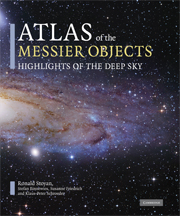Book contents
- Frontmatter
- Dedication
- Contents
- Foreword
- Preface
- User Guide
- Charles Messier
- The Observations
- The Catalog
- Statistics of the Messier objects
- Visual observation of the Messier objects
- Photography of the Messier objects
- The 110 Messier objects
- Glossary of technical terms
- Index of figures
- Index of sources
The Observations
Published online by Cambridge University Press: 05 August 2015
- Frontmatter
- Dedication
- Contents
- Foreword
- Preface
- User Guide
- Charles Messier
- The Observations
- The Catalog
- Statistics of the Messier objects
- Visual observation of the Messier objects
- Photography of the Messier objects
- The 110 Messier objects
- Glossary of technical terms
- Index of figures
- Index of sources
Summary
Work on the catalog
M 1 and M 2: Beginnings and motivation
Charles Messier's first encounter with a nebulous object occurred during his preparations for the return of Comet Halley. When he observed Comet de la Nux for that purpose in August 1758, he came across an object in Taurus, which looked very similar to the comet, but it did not move. It was the 28th of August 1758 when Messier discovered the Crab Nebula, now known as M 1. He obtained the position of this apparently new nebula two weeks later (12th of September). Messier did not know then that M 1 had already been found by Charles Bevis in England in 1731, and so took his observation for a new discovery. That kindled an interest that would eventually lead to his famous catalog. As he described it in 1801:
What made me produce this catalog was the nebula which I had seen in Taurus, September 12, 1758, while I was observing the comet of that year. The shape and brightness of that nebula reminded me so much of a comet, that I undertook to find more of its kind, to save astronomers from confusing these nebulae with comets. I continued to observe with telescopes suitable for the discovery of comets, which was the purpose I had in mind when producing this catalog.
Messier did not start a systematic search straight away. However, it was two years before he found M 2, with a Gregorian reflector of 30-inch focal length and a power of 104×. Only later was he to learn, during a search for comet observations from other astronomers, that this object had already been discovered in 1746 by Jean-Dominique Maraldi (1709–1788). Again, Messier was not the original discoverer.
M 3 to M 40: Systematic search for nebulae
In May 1764, Messier finally started systematic work on the catalog of nebulae. He began with the “nebulosae” in the lists and literature known to him, in particular those from Hevelius, Huygens, Derham, Halley, de Chéseaux (of which, apparently, he had only an incomplete knowledge), Lacaille, and Le Gentil.
- Type
- Chapter
- Information
- Atlas of the Messier ObjectsHighlights of the Deep Sky, pp. 25 - 38Publisher: Cambridge University PressPrint publication year: 2008



